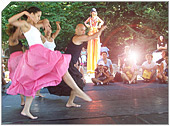Getting Started
Index
NYC Neighborhoods
Manhattan
Brooklyn
Queens
Bronx
Staten Island
NYC Icons
Chrysler Building
Flatiron Building
Empire State Building
Safe NYC
NYPD
FDNY
NYC Weather
NYC Climate
NYC Weather Forecast
Winter Season
Spring Season
Summer Season
Fall Season
NYC History & Politics
New York City History
Tammany Hall and Politics
New York City Politicians
New York City Personalities
Culture of Gotham City
Culture of the city
Cultural diversity
City in popular culture
|
New York City is a minority-majority city. In 2005 44% of the population was white. 25.3% of the population was black or African American, 11.6% was Asian and 0.4% were American Indian. Another 17% belonged to some other race and 1.6% of New Yorkers belonged to more than one race. The city has several demographically unique characteristics. The borough of Queens is the only large county in the United States where the median income among black households, about $52,000 a year, has surpassed that of whites. It is also the nation's most ethnically diverse county
The five largest ethnic groups as of 2005 are: Puerto Ricans, Italians, West Indians, Dominicans, and Chinese. The Puerto Rican population of New York City is the largest outside of Puerto Rico. Italian Americans emigrated to the city in large numbers in the early twentieth century. The Irish, the sixth largest ethnic group in the city, also have a notable presence; one in 50 New Yorkers of European origin carry a distinctive genetic signature on their Y chromosomes inherited from Niall of the Nine Hostages, an Irish high king of the fifth century A.D.
Puerto Ricans
Puerto Ricans have both immigrated and migrated to New York. The first group of Puerto Ricans moved to New York in the mid 19th Century when Puerto Rico was a Spanish Colony and its people Spanish subjects and therefore they were immigrants. The following wave of Puerto Ricans to move to New York did so after the Spanish-American War, when Puerto Rico became an American possession and after the approval of the Jones-Shafroth Act of 1917 which gave Puerto Ricans U.S. citizenship and allowed them to travel without the need of a passport between the island and the United States mainland, thereby becoming migrants. However, the largest wave of migration came about in the 1950s in what became known as "The Great Migration" with the advent of air travel. As a result of the great migration more than a million Puerto Ricans once called New York City home. Now the Puerto Rican population is around 800,000 and New York City still has the largest Puerto Rican population outside of Puerto Rico.
Italians
New York City has a large population of Italian Americans, many of whom inhabit ethnic enclaves in Brooklyn, the Bronx, Queens, and Staten Island.
The largest wave of Italian immigration to the United States took place in the late nineteenth century and early twentieth century. Between 1820 and 1978, 5.3 million Italians immigrated to the United States, including over two million in the years 1900-1910 alone. Only the Irish and Germans immigrated in larger numbers. Italian families first settled in Little Italy's neighborhoods, the first and most famous one being the one around Mulberry Street, in Manhattan. As of the 2000 census 692,739 New Yorkers reported Italian ancestry, making them the largest European ethnic group in the city. New York metropolitan area is home to 3,372,512 Italians, which is the third largest concentration in the world after Milan and Rome metropolitan areas.
Chinese
Like other Chinatown districts in American cities, the Chinatown neighborhood of Manhattan is an ethnic enclave with a large population of Chinese immigrants.
By the 1980s, it had surpassed San Francisco's Chinatown to become the largest enclave of Chinese immigrants in the Western hemisphere, but in the last few years it too has been outgrown by the lesser-known but larger New York City Chinatown community in nearby Flushing, Queens.
Dominicans
A Dominican American or Dominican-York is an immigrant or descendant of immigrants from the Dominican Republic to the United States. Historic immigration records of Dominicans in the United States date from the late 1800s, and New York City had a Dominican community since the 1930s. From the 1960s onward, through the fall of the Trujillo military regime, large waves of migration have thoroughly transnationalized the Dominican Republic, metaphorically blurring its frontier with the United States. There are approximately 1,200,000 Dominican Americans, both native and foreign born.
|
New York City Search
Quick NYC
|



 New York Weather Forecast
New York Weather Forecast
 Ethnic composition
Ethnic composition


















